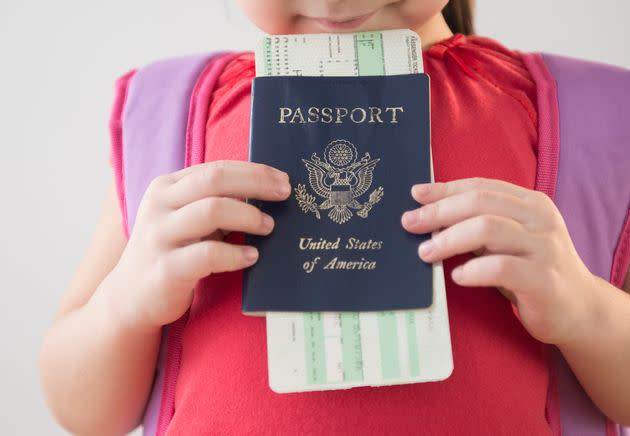The 5 Biggest Mistakes Parents Make With Their Kids' Passports

International travel already requires more planning than domestic trips, but things get more complicated when you add children and their passports into the mix.
“Applying for a child’s passport should be basically easy,” said David Alwadish, the founder and CEO of the passport and visa concierge service ItsEasy.com. In reality, however, the process can feel a bit overwhelming.
“It requires an original birth certificate, the child, and the parents who are listed on the birth certificate to all appear in person before an authorized acceptance agent for the gathering of the documents and witnessing of the parents’ oaths,” Alwadish explained.
But there are many things that can go potentially go wrong, leaving parents scrambling to get their child’s passport in time for an important family visit or big vacation. We asked experts to share the most common mistakes parents make with their children’s passports.
Ignoring the photo guidelines
“Parents often ignore the guidelines for photos in favor of capturing the cutest, most aesthetic passport photo,” said Lousson Smith, a product operations specialist for the flight alert service Going.
If you do periodic family photo shoots or an annual holiday card session, consider asking your photographer to snap a couple of passport photo options. Just remember the photo must show the child against a white background, and they must be the right distance from the camera and in clear focus.
“The No. 1 reason for rejected or delayed applications is poor quality photos,” Alwadish said. “The baby can have a natural smile, but not a giddy smile that distorts the natural flow and contour of face and eyes. The parent can’t be in the photo.”
He noted that your child can’t be wearing a bow, hat or anything on their head. Religious head coverings are acceptable if the parent provides a statement attesting to their religious purpose. Otherwise, the important thing is to ensure the child’s head is up, their eyes are open and they’re facing straight ahead with a non-exaggerated expression.
“Lay the child down safely on your carpet or bed atop a white sheet, so they never can fall, and wait for the perfect moment to take multiple photos until you get the right one,” Alwadish advised.
Submitting incorrect information
“Your mileage may vary but some custom agents will be very particular over information that doesn’t exactly match,” Smith said. “Ensure your child’s name, DOB, and passport information is 100% correct. Also, make sure the parental information is correct and that your own passport doesn’t expire soon.”
She recommended checking that your passport has at least six months of validity until the expiration date.
“Another common error that parents make is they get a blank passport form and fill it out by hand,” Alwadish said. “This practice not only slows the passport agents down from processing the application, having to retype the entries, but also increases the risk of any unforced typographical errors in the finished passport.”
He recommended filling out passport forms online.
Not having both parents appear in person
To prevent international abductions and other issues, the State Department requires both parents or guardians to go with their child to apply for a passport in person. Extra paperwork is necessary when this is not possible.
“Problems start when both parents cannot appear in person and only one does, without the proper consent form, documentation or death certificate,” Alwadish said.
He noted that work conflicts, divorce, custody agreement issues, incarceration or guardianship arrangements might get in the way of both parents appearing in person to apply for the passport.
“If both parents can’t appear, in most cases there is a special form that the remaining parent who will not appear can sign and have notarized,” Alwadish said. “This form, known as a DS 3053, commonly used when the parent that is unable to attend, will give permission to the remaining parent to appear with the child. The same form can be used by both parents to enable a guardian to represent and appear with the child.”
Thinking you can renew it
Don’t confuse the passport rules for children with those for adults. While adult passports are good for 10 years, kids’ passports are only good for five — so just because your passport is good to go for a vacation, your child’s might not be.
“To avoid last-minute scrambles, I recommend setting a reminder to renew the passport at least six months before it expires,” said Sylwia Green, a passport expert at PhotoAiD.
Make a note in your calendar and remember you’ll need to use the same procedure you did for their first passport to reapply after the five years is up.
“Every passport issued to a child under 16 years of age is simply not renewable, so it’s a mistake to explore a renewal,” Alwadish said. “Any passport issued after a child’s 16th birthday, if it’s not lost and they hold it to full-term, is renewable, however.”
Losing it
“When traveling, hold on to your kid’s passport to mitigate the chance they might lose it abroad and keep it with yours,” Smith advised. “Travel with photocopies and pictures of the passport just in case. If you lose it abroad, go to the nearest embassy to get an expedited replacement.”
In addition to safely keeping your children’s passports with yours, Alwadish also recommended getting a passport ID card for your child to carry in case you are separated. It’s more like a regular ID card than a passport, but it’s cheaper, smaller and allows holders to cross some land borders.
“Tape your cell number to the card and make sure it never leaves their person,” he said. “Will that card be the ‘end all’ for security? Probably not, but it is only $15!”

